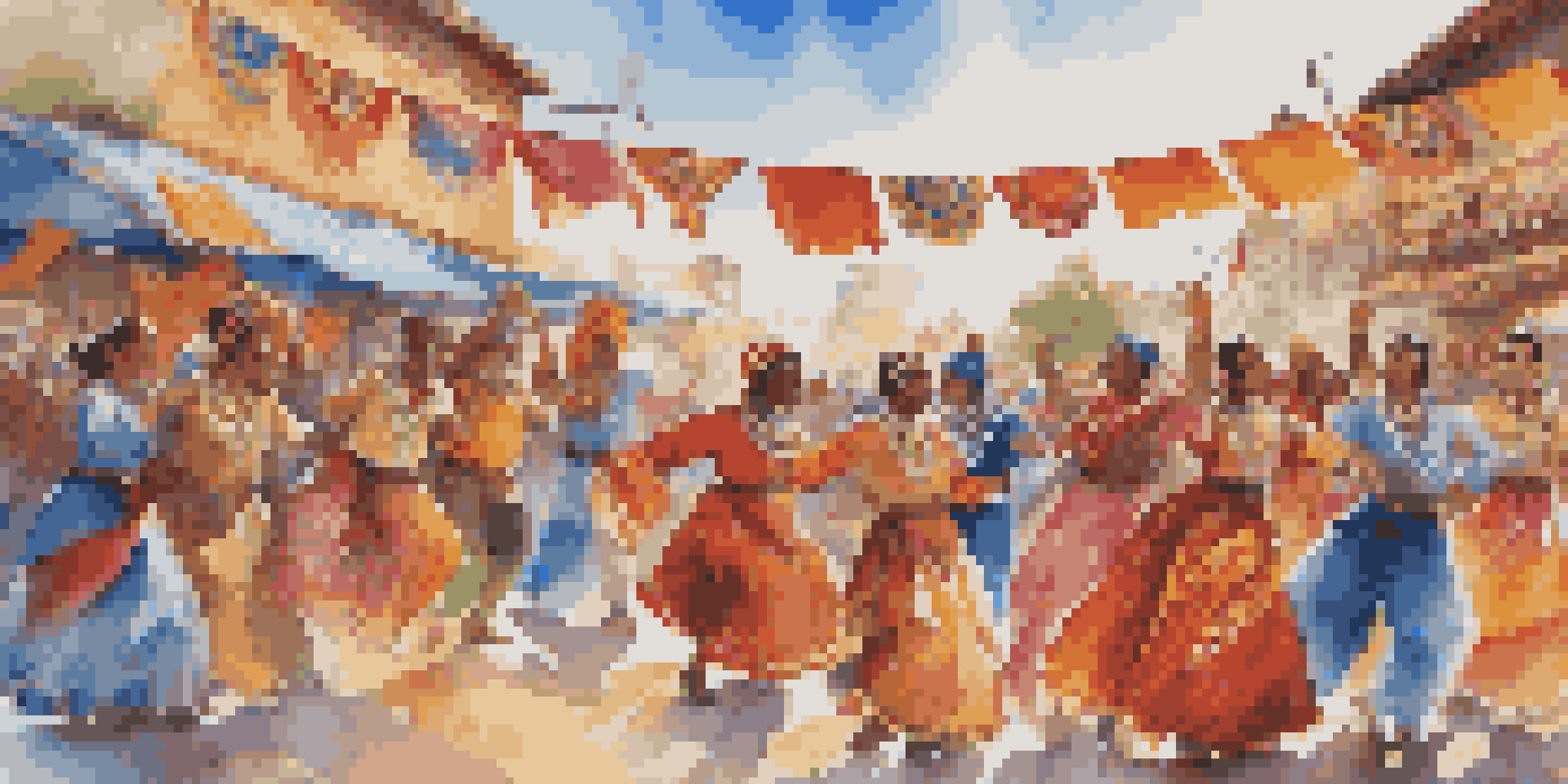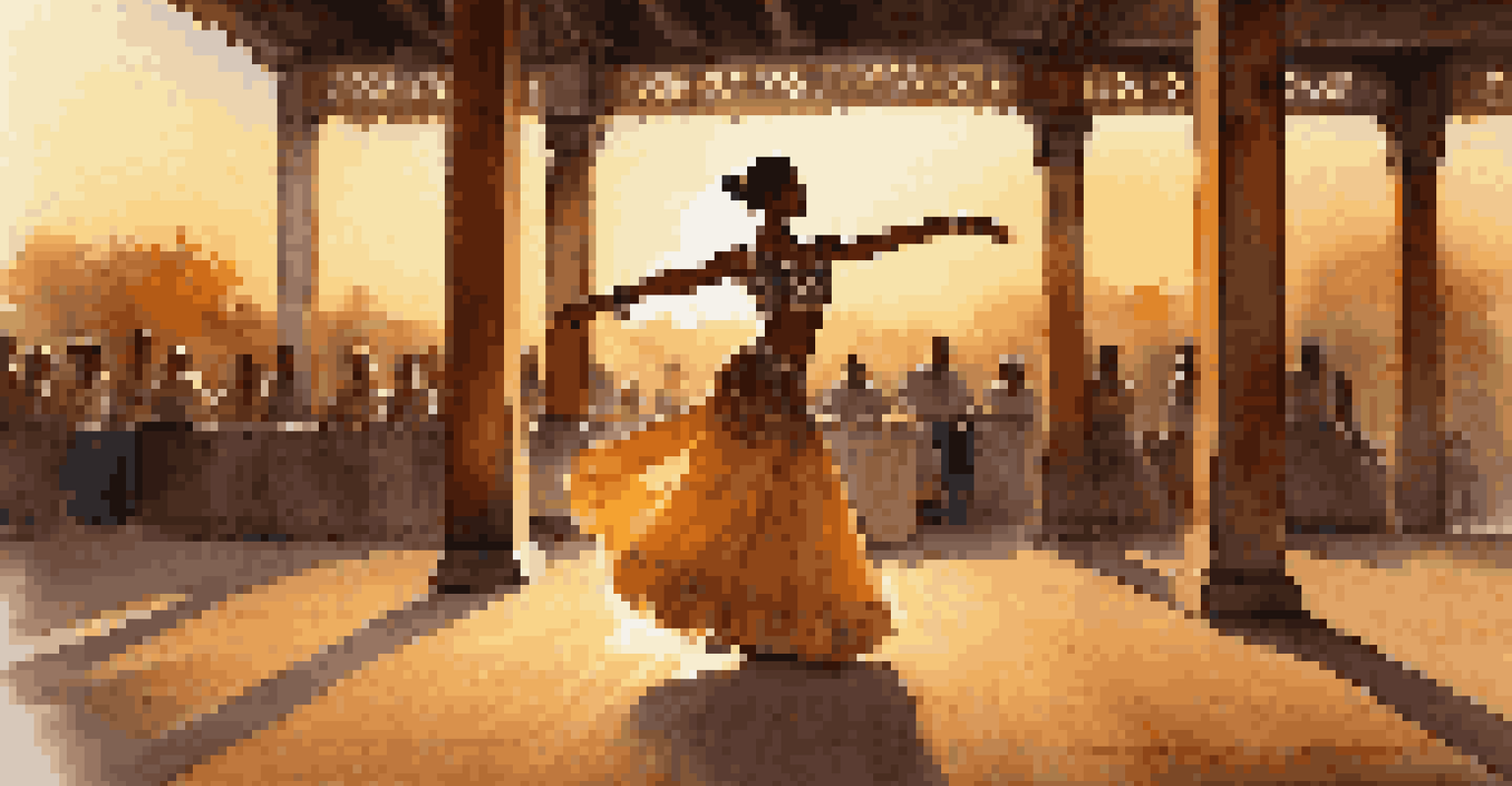Dance Festivals: A Platform for Cultural Storytelling

The Essence of Dance Festivals in Cultural Expression
Dance festivals are vibrant celebrations that bring together diverse cultures, showcasing the unique stories and traditions of each. Through movement, rhythm, and music, these festivals act as a canvas for performers to express their heritage and values. They create a shared space where audiences can connect with cultures that might be different from their own, fostering understanding and appreciation.
Dance is the hidden language of the soul.
Each dance style, whether it's samba, ballet, or traditional folk, carries its own narrative. These narratives often reflect historical events, social issues, or spiritual beliefs, offering deeper insights into the community’s identity. For instance, a traditional dance performance may recount age-old legends, allowing the audience to experience the culture's history firsthand.
Moreover, the shared experience of watching a dance festival cultivates a sense of unity among spectators. It reminds us that, despite our differences, we all share the universal language of movement, making these events not only entertaining but also enriching.
Storytelling Through Dance: A Historical Perspective
From ancient rituals to modern performances, dance has always been a powerful storytelling tool. Historically, many cultures used dance to communicate important life events, such as birth, marriage, and death. These performances were a way to preserve history and pass down traditions through generations, ensuring that cultural stories remained alive.

For example, Native American powwows incorporate dance as a means of storytelling, connecting the community to their ancestors and traditions. Similarly, African dance forms often convey stories of struggle, triumph, and community strength, using movement to express deep emotions and shared experiences.
Dance Festivals Celebrate Cultures
Dance festivals serve as vibrant platforms for performers to showcase their unique cultural narratives, fostering understanding and appreciation among diverse audiences.
Today, dance festivals continue this legacy, providing a platform for artists to reinterpret traditional stories while also sharing contemporary themes. This evolution allows for a broader range of narratives to be told, making dance a dynamic form of cultural expression.
Dance as a Bridge Between Cultures
One of the most beautiful aspects of dance festivals is their ability to bridge cultural divides. As performers from various backgrounds come together, they create a melting pot of styles and influences. This cross-pollination of ideas enriches the dance community and fosters collaboration that transcends borders.
Dancing is like dreaming with your feet.
For instance, a dance festival featuring both traditional Indian classical dance and contemporary hip-hop can showcase how different styles can coexist and inspire each other. This blending not only entertains but also educates audiences about the richness of global cultures, encouraging appreciation and respect.
Moreover, these festivals often invite participation from the audience, allowing them to experience different dance forms firsthand. Such interactions can break down stereotypes and build friendships, creating a more inclusive environment where cultural exchange thrives.
The Role of Technology in Modern Dance Festivals
In recent years, technology has transformed the way dance festivals are experienced and shared. From live-streaming performances to interactive installations, technology enhances audience engagement and expands the reach of these cultural celebrations. This evolution allows people from all over the world to participate, even if they cannot physically attend the event.
For example, virtual reality experiences can immerse viewers in a dance performance, making them feel as if they are part of the action. This innovative approach not only attracts tech-savvy audiences but also brings traditional dance forms to a new generation, ensuring they remain relevant in today’s fast-paced world.
Dance as a Tool for Social Change
Many dance festivals address pressing social issues through performances that inspire dialogue and encourage community action.
Additionally, social media plays a crucial role in promoting dance festivals, allowing performers to share their stories and connect with fans. This online presence helps create a global community where cultures can be celebrated and exchanged, further enriching the dance landscape.
Dance Festivals as Platforms for Social Change
Many dance festivals use their platform to address social issues and raise awareness about important causes. By incorporating themes of activism into their performances, artists can spark conversations and inspire change within their communities. This blending of art and advocacy is a powerful way to engage audiences on pressing matters.
For instance, festivals addressing topics like climate change or social justice often feature performances that reflect these concerns. Dancers may use their art to tell stories of resilience, hope, and community action, encouraging audiences to reflect on their role in creating a better world.
Through these performances, dance becomes a catalyst for dialogue, urging spectators to think critically about societal challenges. This commitment to social change demonstrates how dance can not only entertain but also inspire meaningful action.
The Impact of Globalization on Dance Festivals
Globalization has significantly influenced dance festivals, leading to a fusion of styles and traditions. As cultures interact more than ever, dance forms are continually evolving, creating new and exciting interpretations of traditional movements. This blending enriches the festival experience, offering audiences a diverse range of performances.
While this cross-cultural exchange can be positive, it also raises questions about cultural appropriation. It’s essential for festival organizers and performers to approach this fusion with respect and understanding, acknowledging the origins of the dances they incorporate. By doing so, they can honor the stories behind the movements while celebrating their evolution.
Technology Transforms Dance Experiences
Advancements in technology enhance engagement at dance festivals, allowing global audiences to participate and connect with performances in innovative ways.
Ultimately, globalization presents both opportunities and challenges for dance festivals. By navigating these complexities thoughtfully, festivals can serve as spaces for genuine cultural exchange and storytelling, promoting respect and appreciation for all forms of dance.
The Future of Dance Festivals: Trends to Watch
As we look to the future, dance festivals are likely to continue evolving in exciting ways. One trend to watch is the increasing emphasis on sustainability, with many festivals making efforts to reduce their environmental impact. This focus not only aligns with global movements towards sustainability but also resonates with audiences who are passionate about protecting the planet.
Another emerging trend is the integration of mental health awareness into performances. Dancers are using their art to explore themes of healing, resilience, and the human experience, creating a deeper connection with audiences. This focus on mental well-being reflects a growing recognition of the importance of emotional health in today’s society.

Finally, the incorporation of interactive and immersive experiences will likely become more prevalent. As audiences seek more meaningful connections with performances, festivals that offer hands-on workshops or participatory events will stand out. These trends indicate that the future of dance festivals will be dynamic, inclusive, and deeply rooted in cultural storytelling.